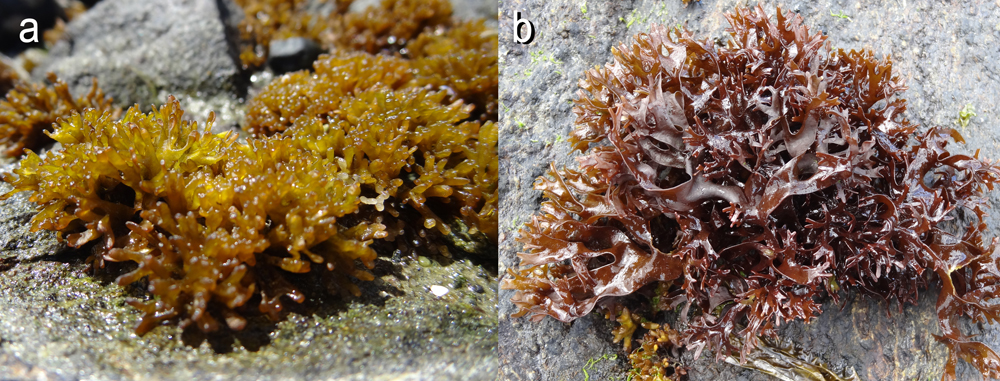
Article by Sandra Lindstrom, Paul Gabrielson, Jeff Hughey, Erasmo Macaya and Wendy Nelson.
This project is not something I ever envisioned. How did someone who is interested in the biogeography and phylogeny of seaweeds occurring on the West Coast of North America end up leading a project that revised the taxonomy of a genus of seaweeds known only from the Southern Hemisphere? It was in fact because of my interest in a genus of predominantly Northern Hemisphere species (Mastocarpus, the Turkish washcloth) that I asked Paul Gabrielson to collect specimens of that genus for me in Chile. What he collected turned out to be something different when I sequenced the specimens. When the sequences were blasted against the GenBank database in 2008, they came out closest to another Northern Hemisphere group I was interested in (the Palmariaceae). Moreover, those sequences represented three different species of Nothogenia fastigiata.
In 2009 I discussed my observations with Max Hommersand and Wendy Nelson, two people with Southern Hemisphere interests, at a conference in Tokyo. Both encouraged me to pursue work on the genus with promises to send me material from their own collections. This resulted in sequences of additional cryptic species from New Zealand and beyond. Since a number of species names had previously been subsumed in Nothogenia fastigiata, it became necessary to sequence the type specimens of these species to determine whether any of these names could be resurrected to apply to the cryptic species I had uncovered. Time to call in the guru of ancient DNA sequencing: Jeff Hughey.
Finally, at a conference in Orlando, Florida, in 2013 I heard a talk by Erasmo Macaya on diversity in Chilean Nothogenia. His results mirrored my own. Paul and I invited Erasmo to join the project, and Erasmo subsequently sent me dozens of Chilean collections to sequence.
In the end, I sequenced the ribosomal ITS regions and the rbcL, psbA and COI genes in up to 56 Nothogenia specimens, plus a few other species that collectors had misidentified as Nothogenia. Together with Jeff’s sequencing of type specimens, we were able to recognize 10 species of Nothogenia in the Southern Hemisphere, including four that were resurrected from previous synonymy with N. fastigiata and one newly described species. Most of these species occur in geographically restricted areas, but N. fastigiata appears to indeed be widespread, with collections verified from its type locality of the Falkland Islands, from Chile, and from Campbell Island south of New Zealand. Another surprise was that Tasmanian N. lingula is more closely related to N. fastigiata and other Chilean species than to the geographically closer New Zealand or South African species. Several Chilean species remain undescribed, and it has fallen to Erasmo to take the lead on these.
Unfortunately, long before this project was completed, my NSERC research funding expired. Thus, most of the expenses associated with sequencing were covered by funds from a Census of Marine Life grant and from my mother. I covered all other expenses myself.
S.C. Lindstrom, P.W. Gabrielson, J.R. Hughey, E.C. Macaya & W.A. Nelson. 2015. Sequencing of historic and modern specimens reveals cryptic diversity in Nothogenia (Scinaiaceae, Rhodophyta). Phycologia 54: 97-108.
Caption: Photos showing the different morphologies of Nothogenia fastigiata (a) and Nothogenia “C” (b), the only species of Nothogenia to co-occur on the same shore in Chile (courtesy of Erasmo Macaya)